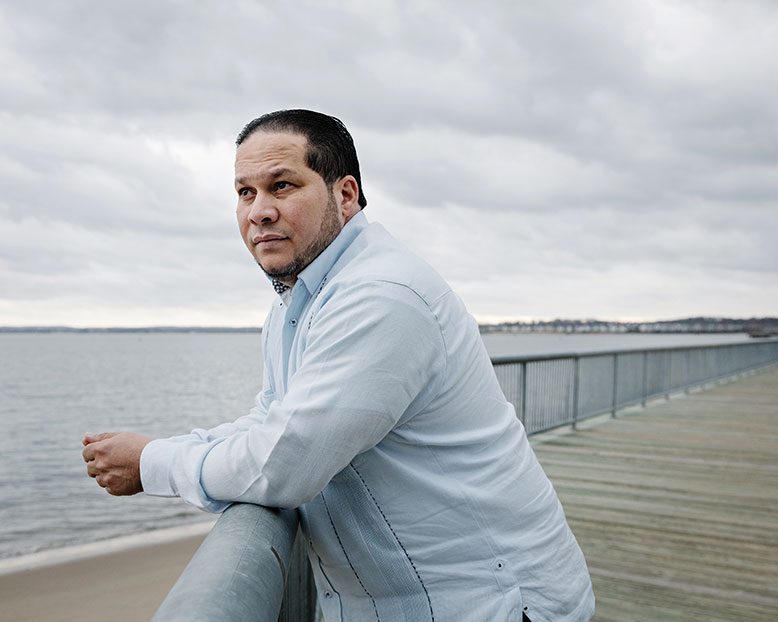
Fausto Diaz remembers translating for his newly arrived countrymen when he was a teenager in Perth Amboy.
“If you came from the Dominican Republic, they knew you were a good worker, and you were hired on the spot,” says Diaz, who used to help new arrivals get identity cards so they could work at a local factory. “You’d come here on a Sunday, and you went to work on Monday.”
Diaz, 68, was one of the first Dominicans to graduate from Perth Amboy High School; he was the first to go to college. His father, Jose Diaz, brought the family to Perth Amboy in 1968. They were among the original Dominicans to settle here.
Today, 78 percent of Perth Amboy’s population of about 53,000 is Latino. Dominicans are the largest subgroup, says Dominican-born Irving Lozada, assistant to Mayor Wilda Diaz (herself of Puerto Rican descent). According to 2009 figures from the Institute for Latin Studies, the city, where the Raritan River meets the Arthur Kill, has the highest concentration of Dominicans in the country. In New Jersey, Dominicans are the second largest immigrant group after Indians, accounting for 8.4 percent of the state’s newcomers.
Jose Diaz originally immigrated in 1964 to Corona, Queens, joining an exodus from the Dominican Republic after the 1961 assassination of its dictator, Rafael Trujillo. Permanent resident visas were plentiful; a Dominican in the United States could apply for one for family members or friends. “They felt they owed it to the rest of the family to help them come over,” says Fausto.

“We came from a land where everyone was Dominican…Here, everyone is something else.” – Sergio Diaz Photo by Axel Dupeux
The new arrivals were hardworking, humble people, many from El Cibao, an agricultural region. Jose Diaz had been the mayor of his Dominican town, though he had no more than a fourth-grade education.
Jose moved his family from Queens to Perth Amboy at a cousin’s suggestion. Berger Industries, a pipe factory in nearby Edison, was hiring. Fausto was a teenager at the time. In 1972, Fausto’s cousin, Sergio, and his family joined the clan in Perth Amboy. At first, the going was tough for Sergio. Back then, all classes were taught in English. Sergio had to repeat sixth grade. “Even if kids spoke Spanish, they were not allowed to speak to you in Spanish,” he recalls. “You were forced to pick up the language, and you missed a lot in between.” Many of Sergio’s peers dropped out to work as soon as they could.
“It was a trial-and-error period,” says Fausto—very different from the bilingual education available today.
Adjusting to Perth Amboy’s diversity was another issue for Sergio. “We came from a land where everyone was Dominican; there were no other nationalities,” says Sergio. “You come here, and everyone else is something else.” At times, it was even hard to relate to other Spanish speakers. “I didn’t know anyone from Mexico before,” he says.
Slowly, the Dominican community’s presence grew. Today, almost three-quarters of the businesses in Perth Amboy are minority owned, most by Dominicans, says Lozada. Sergio, 57, estimates his uncles have about 400 descendants in Perth Amboy, including military veterans and entrepreneurs. A distant cousin, Darius Diaz, is a star high school catcher and considered one of the best young ballplayers in the state.
Sergio, Fausto and Fausto’s wife, Celeste, own a tax-preparation franchise; Sergio is also a vice president at Cranbury-based 1st Constitution Bank. Lozada, 44, a former restaurateur in town and a longtime friend of the Diazes, promotes and is executive producer of the 25-year-old Dominican Festival, run by United Dominicans of Perth Amboy. The festival, slated this year for August 10-12, draws at least 15,000 attendees from as far away as Florida.
The community celebrates two independence days, one on February 27 and one to commemorate restoration of independence on August 16, and the feast day of the patron saint of the Dominican Republic, Our Lady of Highest Grace, on January 21.
A few blocks from the site of the Dominican Festival, Caledonia/Roessler/Hon. Juan Pablo Duarte Park symbolizes Perth Amboy’s diversity. The park’s name honors the city’s Scottish founders and subsequent German immigrants; more recently, it added a statue of Juan Pablo Duarte, father of Dominican independence. The statue is flanked by busts of the Polish heroes Casimir Pulaski and Nicolaus Copernicus, as well as flags representing Greece, Hungary, Ireland, Israel, Mexico, Peru, Poland, Portugal, Slovakia and Ukraine. “I’m sure the Dominicans are not going to stay being the biggest population in Perth Amboy forever,” says Lozada, who notes that Puerto Ricans made up most of the Latino population in earlier years, while the numbers of Mexicans and South Americans are growing.
Sarah Aponte, the chief librarian of the Dominican Studies Institute at the City College of New York, says that while many Dominicans used to return to their native land to retire, most now stay in the United States for good.
“They’re even buying plots in the cemetery, no longer burying people back home,” she says. “This is our home, too.”




Great piece, just a correction: the highest concentration of Dominicans in the US is located in the Bronx, New York.